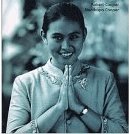Orchids In Thailand
 Orchids In Thailand
Orchids In Thailand Most admirers of the Orchidaceae will already be familiar with Thai orchids courtesy of the much loved Dendrobium, the World's most popular genus of orchid. Dendrobium was Thailand’s introduction to the World Orchid industry, easy to grow, fast flowering and with up to 30 long lasting orchid sprays a year, the Dendrobium genus elevated Thailand to the top of the Asian orchid exporting market. In it’s present state, so huge is the Thai Orchid industry that the national airline, Thai Airways, routinely ships over 3,500 kg of orchids on each of its four weekly flights to Scandinavia alone! The Japanese market meanwhile is worth an annual turnover of US$100 million to the Thai nation.
Most admirers of the Orchidaceae will already be familiar with Thai orchids courtesy of the much loved Dendrobium, the World's most popular genus of orchid. Dendrobium was Thailand’s introduction to the World Orchid industry, easy to grow, fast flowering and with up to 30 long lasting orchid sprays a year, the Dendrobium genus elevated Thailand to the top of the Asian orchid exporting market. In it’s present state, so huge is the Thai Orchid industry that the national airline, Thai Airways, routinely ships over 3,500 kg of orchids on each of its four weekly flights to Scandinavia alone! The Japanese market meanwhile is worth an annual turnover of US$100 million to the Thai nation. On this trip it is wild orchids that will be our focus. With around 1150 currently known species of Orchidaceae in Thailand, there is a lot to learn and see. We will explore many different habitats in northern and central Thailand, meeting face to face with wild ‘gluay mhai’, the Thai for ‘orchid’, specimens both rare and common. At least seven genera will be seen in the wild including Dendrobium, Vanda, Ascocentrum, Rhynchostylis, Bulbothyllum, Coelogyne and Pathiopedilum. By visits to Botanical Gardens, academic projects and a great deal of time spent in the field we will all leave Thailand with our knowledge and appreciation of this Queen of flora much endowed.
On this trip it is wild orchids that will be our focus. With around 1150 currently known species of Orchidaceae in Thailand, there is a lot to learn and see. We will explore many different habitats in northern and central Thailand, meeting face to face with wild ‘gluay mhai’, the Thai for ‘orchid’, specimens both rare and common. At least seven genera will be seen in the wild including Dendrobium, Vanda, Ascocentrum, Rhynchostylis, Bulbothyllum, Coelogyne and Pathiopedilum. By visits to Botanical Gardens, academic projects and a great deal of time spent in the field we will all leave Thailand with our knowledge and appreciation of this Queen of flora much endowed. Our itinerary has been drawn up in consultation with local orchid experts and is designed to render a thorough exploration of known, though little visited, habitats of Thai orchids. The best time to see flowering wild orchids in Thailand is March through April and we have timed our 2003 trip to coincide with this prime period. At this time of year whole hillsides can be seen decked with orchid flowers through all levels of the forest.
Our itinerary has been drawn up in consultation with local orchid experts and is designed to render a thorough exploration of known, though little visited, habitats of Thai orchids. The best time to see flowering wild orchids in Thailand is March through April and we have timed our 2003 trip to coincide with this prime period. At this time of year whole hillsides can be seen decked with orchid flowers through all levels of the forest.Orchids are not the only facet of Thailand we will explore. Having never been colonised by a Western power the culture in Thailand is robust and as pure as you can expect from any modern nation. It would be an absolute crime therefore to go all that way and ignore the livelihoods and lifestyles of our hosts. In this way the itinerary makes use of accommodation and resources run by local people benefiting and sustaining their lifestyles, we explore classic temples and palaces, village life of both Thai and hilltribe people, the importance of weaving and food, ancient ruined capitals of past Kingdoms, the history and religious beliefs of today’s Thai people.

0 Comments:
Post a Comment
<< Home